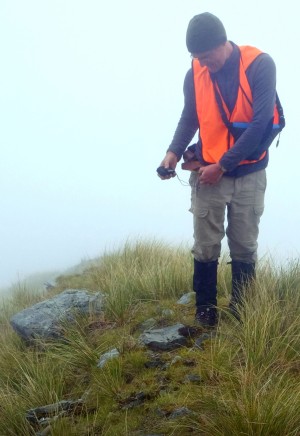
Isaac Larsen (University of Massachusetts- Amherst) on one of the narrow tussock ridges, just before digging a soil pit.
It occurs in multiple ways including by carbonic acid weathering, in which rainwater reacts with carbon dioxide (CO₂) to form carbonic acid (H₂CO₃), a weak acid that in turn reacts with rocks. This process dissolves the minerals in the rocks and releases mineral nutrients, but the same reaction also removes CO₂ from the atmosphere.
This CO₂ removal function is important on geological (very long!) timescales, preventing a runaway greenhouse effect on Earth.
There is ongoing debate about what is the primary driver of carbonic acid weathering on the Earth’s surface.
For a long time, abundant plant cover was regarded as essential for high rates of this process.
However, as with most relationships, the dynamics of the weathering process are complicated, says an international team that included Manaaki Whenua’s Dr Andre Eger, in a paper published in Earth and Planetary Science Letters. After sampling soils and rocks across vegetation and erosion gradients on the western Southern Alps the team discovered that chemical weathering is driven more by erosion than vegetation.
Erosion breaks up rocks mechanically, creating fractures that allow rainwater to supply carbonic acid directly to the rocks. Plant roots, together with associated microbiota, greatly enhance this process by increasing the CO₂ concentration in the soil, producing even more acids that can react with the rock.
The team sampled soils and rocks across vegetation and erosion gradients on Gunn Ridge in the upper Whataroa valley. To estimate erosion, they measured a rare variant (isotope) of the element beryllium that only forms when particles from supernova explosions collide with Earth.
While it sounds like science fiction, this has become one of the go-to methods to measure long-term erosion rates in earth science.
“We found the highest rates of chemical weathering occurred in the locations with the highest erosion rates, locations of high topographic convexity, like very pointy ridgetops,” says Andre.
“The vegetation cover had surprisingly little control over these rates. Thus, it appears that processes that directly shape the topography, like river incision in response to the tectonic uplift of a mountain range, are more important for weathering rates than vegetation, at least in our study area.”
Apart from increasing fundamental understanding of long-term, landscape-scale processes, the work is relevant to current attempts to harness the natural process of chemical weathering of rock as a mitigation technique against anthropogenic global warming.
